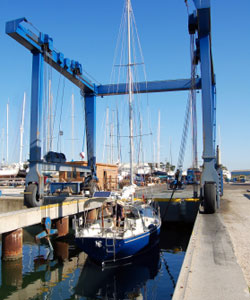
Once you've bought your new boat, you could be charged over £1,000 for commissioning. Commissioning involves a great deal of hard work and although it's an added expense on your extras list, it's something you should consider carefully.
Gas Installation
Standards for gas installation have been harmonised throughout Europe so it would be legal to fit a bottle and light the cooker - providing the boat isn't destined for charter or commercial use. However, it's best not to take chances and engage the services of a professional to carry out some upgrades. Although all the essentials on your new boat will be ready to use, it's always best to get the pipes tested and all the correct terminations added. You don't want to take any chances with gas.
Masthead Electrics
Having to climb the mast when things stop working is a nuisance, so silicone grease can be used on electrical connections to the VHF aerial, masthead light and wind instruments. Most grease inhibits corrosion although oil-based grease will corrode plastic and rubber seals, so on the masthead electrics use silicone grease. Another useful tip at the masthead is to leave a loop in the cable to the VHF aerial to encourage drips to fall off. Water is more likely to get in if the cable is pulled tight.
Rigging
Dressing and stepping the mast and setting up the rig is a complex process. The mast will usually arrive with the running rigging already roven and the roller-reefing system assembled. You may have to attach the spreaders and the standing rigging. This may involve some pinning and drilling holes in to the mast to insert rivets to secure the terminals of the lowers, intermediates, forestay and cap shrouds. When everything is fitted and on the correct side, the mast can be stepped.
Engine and Saildrive
Before launching it's vital to fill the gearbox with oil to make sure the seals in the gearbox work correctly. If you launch the boat before doing this, the seals will not be watertight.
Launching
Putting your boat in to the water is not the end of the commissioning process but is a significant step towards it! As the boat is lowered, check below for leaks from skin fittings and before casting off, check the engine, steering and gear-shift.
Other jobs
Among all the other larger jobs, you must remember:
- Applying the self-adhesive names
- Measuring, cutting and splicing the mooring warps
- Making up the anchor chain
- Canvas work
- Skin fittings and seacocks
- And finally, putting diesel in the tank!
So much work is involved in commissioning a boat. It takes many man hours, especially when a boat has travelled some distance - you should be prepared to fix things that have been damaged in transit. Whether or not everything is present and correct, there are good and bad ways of carrying out the work on your boat so it's worth considering where and by whom your new boat is to be commissioned.